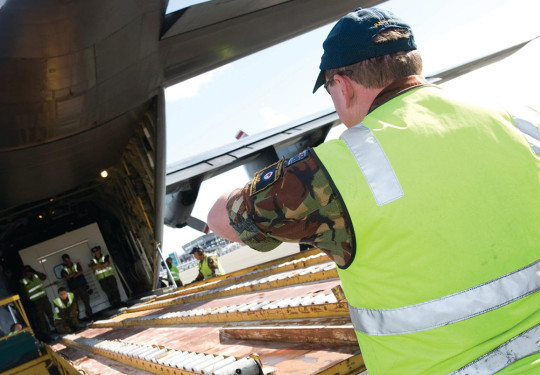Air Force remembers, ten years on
22 February, 2021
Ten years ago New Zealand Defence Force (NZDF) personnel were in the South Island gearing up for the NZDF’s bi-annual exercise, Southern Katipo. Troops were ready, air assets were on the tarmac and HMNZS Canterbury was berthed at Lyttelton Port making final preparations before the exercise got underway.
Then, at 12:51pm on Tuesday 22 February 2011 a 6.3-magnitude earthquake struck the city of Christchurch. The earthquake killed 185 people and injured thousands and caused severe damage in Christchurch and Lyttelton. The NZDF responded by undertaking its largest-ever humanitarian assistance mission.
The Royal New Zealand Air Force (RNZAF) responded quickly following the earthquake deploying a P-3K2 Orion to survey the damage of the city and assess what was needed in the response.
Nathan McMaster (then Flight Lieutenant) was the aircraft captain on Search and Rescue 228 that day.
“I vividly recall seeing the city and how it resembled a warzone. I don’t think any of us were prepared for what we saw. The CTV building was on fire, which we hadn’t been expecting,” he said.
Mr McMaster and his crew from No.5 Squadron had been on standby for Search and Rescue duties that day. On the day of the earthquake, their role was to provide an assessment of the damage to critical infrastructure in and around Christchurch city, including bridges, rail lines, sewerage treatment plants, and major roads in and out of the city.
Mr McMaster said multiple helicopters were working back and forth beneath the aircraft and with a cloud base at 1,100 feet the available space was tight, but it worked.
“Throughout the time we were there more helicopters continued to arrive and ask what they could do to help.’’
Images that stick in his mind include rail way lines bent and distorted like strands of spaghetti and houses missing entire roofs with piles of tiles on the ground next to them.
“It was incredibly sobering to see the destruction wrought on the city. But my enduring memory was seeing and hearing people doing everything they could do to help - whether it was those on the ground we saw assisting others, or those in helicopters arriving from all points throughout the South Island and asking what can they do to help,” said Mr McMaster. “It was amazing to see’’.
Flight Sergeant (F/S) Tony Strugnell also remembers it well. He was one of two flight engineers on the reconnaissance flight over the city.
Stationed at an observed window, he was responsible for passing visual reports of damage to the tactical crew.
“I was surprised at the extent of the damage. We hadn’t seen any news footage or pictures so had no idea how bad the earthquake was till we were over the city.
“The first time I realised that there was probably significant loss of life was when we saw the remains of the CTV building and the rescue teams at work. From that point on we actually tried to remain clear of major disaster areas like that as we didn’t want to be a distraction for rescue operations,” he said.
F/S Strugnell said that from the air it felt quite surreal and detached.
He has responded to natural disasters multiple times before and had carried out disaster reconnaissance flights in the Pacific Islands “so I was used to seeing a reasonable amount of devastation”.
“The difference here, was this time the scale was larger, and it was closer to home.
“From the air it almost seemed like the earthquake had been quite selective, a row of buildings would appear absolutely normal while another would be complexly flattened,” he said.
The RNZAF’s Boeing 757s, C-130 Hercules, Kingair and Iroquois helicopters, as well as the P-3K2 Orions moved 4278 passengers and huge consignments of equipment to and from the city during the relief effort.
W/O John Beere was on the ground in Christchurch when the earthquake hit. An Air Load Master Instructor at No.40 Squadron at the time, they were conducting training and support flights for Exercise Southern Katipo 11.
W/O Beere was in the C-130 when the quake struck and said it felt like the aircraft had been hit or that a strong wind gust was passing by. But the aircraft kept shaking.
Following the quake the focus quickly shifted from training to a Humanitarian Aid and Disaster Relief (HADR) type scenario, and the C-130 started evacuating people out of the city.
“Once the earthquake struck we were placed into crews and we started evacuation flights out of Christchurch to Wellington. The first flight was a large number of foreign dignitaries that had been at a conference in the city.
“Christchurch airport runway was closed to all civilian traffic, but the C-130 was permitted to operate,” he said.
W/O Beere said it was high tempo on the ground and very similar to previous overseas HADR support flights, except it was at home.
“Flights were continuous, it was pretty much a 24-hour operation with crews flying into Christchurch with supplies and equipment, re-rolling the aircraft, and then flying max passengers out to Wellington.
“This type of work for us is what we train to do, but unfortunately you do not expect to have to do it in New Zealand,” said W/O Beere.
1,796 Defence Force personnel made up of 239 Navy, 1,379 Army and 150 Air Force regular and reserve personnel were directly involved on the ground in Christchurch in 2011. Behind these people were many more working in support from camps and bases around the country. The support ranged from medical, logistical, and planning, to engineering tasks, cordon maintenance, and forensic dentistry.
